Sachsenhausen concentration camp

| Part of a series on | ||||||||||
| The Holocaust | ||||||||||
|---|---|---|---|---|---|---|---|---|---|---|
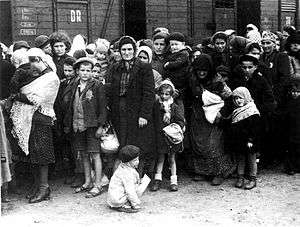 | ||||||||||
|
||||||||||
|
Atrocities |
||||||||||
|
Camps
|
||||||||||
|
Lists Deportations of French Jews
to death camps |
||||||||||
|
Remembrance |
||||||||||
Sachsenhausen ("Saxon's Houses", German pronunciation: [zaksənˈhaʊzən]) or Sachsenhausen-Oranienburg was a Nazi concentration camp in Oranienburg, Germany, used primarily for political prisoners from 1936 to the end of the Third Reich in May 1945. After World War II, when Oranienburg was in the Soviet Occupation Zone, the structure was used as an NKVD special camp until 1950 (See NKVD special camp Nr. 7). The remaining buildings and grounds are now open to the public as a museum.
Sachsenhausen under the Nazis
The camp was established in 1936. It was located 35 kilometres (22 mi) north of Berlin, which gave it a primary position among the German concentration camps: the administrative centre of all concentration camps was located in Oranienburg, and Sachsenhausen became a training centre for Schutzstaffel (SS) officers (who would often be sent to oversee other camps afterwards). Executions took place at Sachsenhausen, especially of Soviet prisoners of war. During the earlier stages of the camp's existence the executions were done in a trench, either by shooting or by hanging. A large task force of prisoners was used from the camp to work in nearby brickworks to meet Albert Speer's vision of rebuilding Berlin.[1] Sachsenhausen was originally not intended as an extermination camp—instead, the systematic murder was conducted in camps to the east. In 1942 large numbers of Jewish inmates were relocated to Auschwitz. However the construction of a gas chamber and ovens by camp-commandant Anton Kaindl in March 1943[2] facilitated the means to kill larger numbers of prisoners.
Camp layout
The Main gate or Guard Tower "A", with its 8mm Maxim machine gun, the type used by the Germans in the trenches of World War I, housed the offices of the camp administration. On the front entrance gates to Sachsenhausen is the infamous slogan Arbeit Macht Frei ("work makes (you) free"). About 200,000 people passed through Sachsenhausen between 1936 and 1945. Anchoring the base of the triangular shaped thousand-acre site was the large Appellplatz, where tens of thousands of prisoners would line up for morning and evening roll call. Creating a semi circular configuration, were the barracks of custody zone I which fanned out from the base of the Appellplatz.
Sachsenhausen was intended to set a standard for other concentration camps, both in its design and the treatment of prisoners. The camp perimeter is, approximately, an equilateral triangle with a semi circular roll call area centered on the main entrance gate in the boundary running northeast to southwest. Barrack huts lay beyond the roll call area, radiating from the gate. The layout was intended to allow the machine gun post in the entrance gate to dominate the camp but in practice it was necessary to add additional watchtowers to the perimeter. The standard barrack layout was to have a central washing area and a separate room with toilet bowls and a right and left wing for overcrowded sleeping rooms.
There was an infirmary inside the southern angle of the perimeter and a camp prison within the eastern angle. There was also a camp kitchen and a camp laundry. The camp's capacity became inadequate and the camp was extended in 1938 by a new rectangular area (the "small camp") northeast of the entrance gate and the perimeter wall was altered to enclose it. There was an additional area (sonder lager) outside the main camp perimeter to the north; this was built in 1941 for special prisoners that the regime wished to isolate.
Custody zone

The camp was secure and there were few successful escapes. The perimeter consisted of a 3-metre-high (9.8 ft) stone wall on the outside. Within that there was a space that was patrolled by guards and dogs; it was bordered on the inside by a lethal electric fence; inside that was a gravel "death strip" forbidden to the prisoners. Any prisoner venturing onto the "death strip" would be shot by the guards without warning. Officers would also force prisoners to cross this strip at gun point and threaten to kill the prisoner if they did not cross, in the end the prisoner would cross the death strip and get killed anyway. Rewards such as extra leave were offered to guards who successfully shot and killed any prisoner who entered onto the death zone.[3]
Prisoner labour
Sachsenhausen was the site of Operation Bernhard, one of the largest currency counterfeiting operations ever recorded. The Germans forced inmate artisans to produce forged American and British currency, as part of a plan to undermine the British and United States' economies, courtesy of Sicherheitsdienst (SD) chief Reinhard Heydrich. Over one billion pounds in counterfeit banknotes were recovered. The Germans introduced fake British £5, £10, £20 and £50 notes into circulation in 1943: the Bank of England never found them. Plans had been made to drop British pounds over London by plane.[4] Today, these notes are considered very valuable by collectors.
An industrial area, outside the western camp perimeter, contained SS workshops in which prisoners were forced to work; those unable to work had to stand at attention for the duration of the working day. Heinkel, the aircraft manufacturer, was a major user of Sachsenhausen labour, using between 6,000 and 8,000 prisoners on their He 177 bomber. Although official German reports claimed the prisoners were "working without fault", some of these aircraft crashed unexpectedly around Stalingrad and it is suspected that prisoners had sabotaged them.[5] Other firms included AEG and Siemens. Prisoners also worked in a brick factory, which some say was supposed to supply the building blocks for Hitler's dream city, Welthauptstadt Germania, which was to be the capital of the world once the Nazis took over.
Prisoner abuses
Camp punishments could be harsh. Some would be required to assume the "Sachsenhausen salute" where a prisoner would squat with his arms outstretched in front. There was a marching strip around the perimeter of the roll call ground, where prisoners had to march over a variety of surfaces, to test military footwear; between 25 and 40 kilometres (16 and 25 mi) were covered each day. Prisoners assigned to the camp prison would be kept in isolation on poor rations and some would be suspended from posts by their wrists tied behind their backs (strappado). In cases such as attempted escape, there would be a public hanging in front of the assembled prisoners.
Dr Wolfgang Wirth did experiments using the lethal poison gas, Sulfur mustard, in the camp.[6] [7]
There have also been allegations of an experimental drug tested upon unwilling inmates in 1944 designated, "D-IX,"[8] at the Saschsenhausen facility. Designed to increase stamina and endurance, this drug, supposedly consisting of a cocktail of cocaine, methamphetamine (Pervitin), and oxycodone (Eukodal),[9] was designed to see use from members of the Werhmacht, Kriegsmarine and Luftwaffe to enhance mission performance where longevity and exhaustion become pertinent issues. While these drugs were used in their individual forms by all branches of the German military, the nature and use there of D-IX specifically (especially experimentation upon Saschsenhausen prisoners) lacks enough substantiation to be considered credible, though experiments by the Nazis upon unwilling prisoners utilizing psychoactive compounds is far from myth, and could hardly be ruled outside the realm of plausibility.
Aftermath
Some 30,000 inmates died there from exhaustion, disease, malnutrition, pneumonia, etc. due to the poor living conditions. Many were executed or died as the result of brutal medical experimentation. Over the course of its operation, over 100 Dutch resistance fighters were executed at Sachsenhausen. The Dutch subsequently sought the extradition from Czechoslovakia of Antonín Zápotocký, who became President of Czechoslovakia, for his alleged role in the murder of the Dutch during his time as a kapo at the camp. According to an article published on 13 December 2001 in The New York Times, "In the early years of the war the SS practiced methods of mass killing there that were later used in the Nazi death camps. Of the roughly 30,000 wartime victims at Sachsenhausen, most were Russian prisoners of war".[10][11]
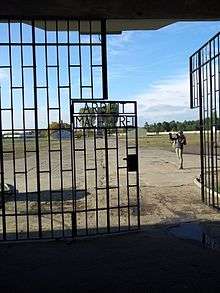
Many women were among the inmates of Sachsenhausen and its subcamps. According to SS files, more than 2,000 women lived in Sachsenhausen, guarded by female SS staff (Aufseherin). Camp records show that there was one male SS soldier for every ten inmates and for every ten male SS there was a woman SS. Several subcamps for women were established in Berlin, including in Neukölln.
Sachsenhausen female guards included Ilse Koch, and later Hilde Schlusser. Anna Klein is also noted for her presence at the camp.
Towards the end of the war, 13,000 Red Army POWs arrived at Sachsenhausen. Over 10,000 were executed in the camp by being shot in the back of the neck through a hidden hole in a wall while being measured for a uniform. Their bodies were then incinerated in a crematorium.
With the advance of the Red Army in the spring of 1945, Sachsenhausen was prepared for evacuation. On 20–21 April the camp's SS staff ordered 33,000 inmates on a forced march northeast. Most of the prisoners were physically exhausted and thousands did not survive this death march; those who collapsed en route were shot by the SS. On 22 April 1945 the camp's remaining 3,000 inmates, including 1,400 women were liberated by the Red Army and the Polish Army's 2nd Infantry Division.
Camp commanders
- Michael Lippert, July 1936 – October 1936
- Karl-Otto Koch, October 1936 – July 1937
- Hans Helwig, July 1937 – January 1938
- Hermann Baranowski, February 1938 – September 1939
- Walter Eisfeld, 1939–1940
- Hans Loritz, 1940–1942
- Albert Sauer, 1942–1943
- Anton Kaindl, 1943–1945
Notable inmates and victims during German period
- Tadeusz Banachiewicz, a Polish professor, astronomer, mathematician and geodesist. He was among 184 academics arrested on November 6, 1939, during Sonderaktion Krakau, professors, lecturers, doctors from Jagiellonian University (UJ), AGH University of Science and Technology, Kraków University of Economics(AE) and others.
- Captain Sigismund Payne Best and Major Richard Henry Stevens, British intelligence agents kidnapped during the Venlo Incident, detained at Sachsenhausen before transfer to Dachau concentration camp.
- Trygve Bratteli of the Norwegian Labour Party, later prime minister of Norway
- Taras Bulba-Borovets, Andriy Melnyk and Oleh Stuhl (briefly), Stepan Bandera and Yaroslav Stetsko, Ukrainian nationalist leaders imprisoned until September–October 1944
- Francisco Largo Caballero, Spanish Prime Minister (1937) and trade unionist, arrested in France, he spent most of World War II imprisoned at Sachsenhausen.
- Jack Churchill, placed at Sachsenhausen, later transferred to Tyrol.
- Peter Churchill, British SOE agent, later transferred to Tyrol.
- Leo Clasen, a homosexual survivor of the Holocaust who published an account of his ordeal in 1954 under the pseudonym L. D. Classen von Neudegg.
- Wing Commander Harry Day, Flight Lieutenants Bertram James and Sydney Dowse, RAF pilots, who had escaped during The Great Escape from Stalag Luft III, sent to Sachsenhausen as punishment, where with Jack Churchill and Major Johnnie Dodge escaped via a tunnel built by James and Dowse in September 1944. Recaptured and held in solitary confinement, later returned to the Sonderlager (special camp); transferred to Tyrol.
- Major Johnnie Dodge, a British Army Officer and relation of Winston Churchill who had escaped during The Great Escape from Stalag Luft III. In February 1945, was removed from solitary confinement and sent back to Britain, via Switzerland, to act as a peace envoy to the British Government, arriving just before VE Day.
- Heinrich Düker political supporter of German resistance, survived
- Yakov Dzhugashvili, Joseph Stalin's eldest son, was briefly imprisoned and died there in 1943 under unclear circumstances.

- Georg Elser, opponent of Nazism who attempted to kill Adolf Hitler on his own in November 1939; later moved to Dachau concentration camp.
- Heinrich Feisthauer, political opponent of the Nazi regime and a survivor of Sachsenhausen.
- Einar Gerhardsen of the Norwegian Labour Party, later prime minister of Norway
- Einar Haarr, from Stavanger, Norway,imprisoned in Heinkel, Sachsenhausen concentration camp[12]
- Hans Grundig, German artist.

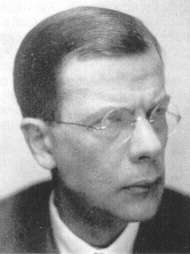
- Herschel Grynszpan, whose 7 November 1938 assassination of the German diplomat Ernst vom Rath served as a pretext for Kristallnacht, 1940 until he was moved to Magdeburg.
- Bayume Mohamed Husen, a black man from Tanganyika (today Tanzania), died in the Sachsenhausen camp[13]
- Dmitry Karbyshev, Red Army general and posthumous Hero of the Soviet Union briefly imprisoned before he was moved to Mauthausen concentration camp.
- Józef Klukowski, Olympic medal-winning Polish sculptor.
- Olaf Kullmann, Norwegian pacifist imprisoned April 1942 and perished there in July of the same year.[14]
- Aksel Larsen, Danish Communist leader, imprisoned 1943 to 1945.
- Julius Leber, German SPD politician, 1933 until 1937, having been declared a "dangerous opponent of the regime".
- Georges Mandel, Minister of Overseas France, 1942–1943.
- Henry Moskowitz, New York based real estate investor and founder of the real estate company The Argo Corporation
- Reverend Martin Niemöller, a critic of the Nazis and author of the statement "First they came ...".
- Oleh Olzhych, tortured to death in June 1944.
- Arnulf Øverland, Norwegian anti-fascist poet.
- Paul Reynaud, the penultimate Prime Minister of France before its defeat by Germany, 1942–1943.
- Stefan Rowecki, chief commander of the Polish Armia Krajowa, imprisoned 1943 and probably executed there in 1944.
- Kurt Schuschnigg, the penultimate Chancellor of Austria before the Anschluss
- Fritz Thyssen, German businessman who emigrated from Germany, imprisoned in Sachsenhausen and later transferred to Dachau.
- Madeleine Truel, Peruvian writer. Author of "The Boy of the Subway". Member of the French Resistance.
- Gottfried Graf von Bismarck-Schönhausen, grandson of Otto von Bismarck, an SS officer aware of the preparations for the 20 July plot to assassinate Hitler, was imprisoned in Sachsenhausen until its liberation by Soviet forces.
- Hasso von Boehmer, German Lieutenant Colonel on the General Staff and 20 July plotter, temporarily detained in the camp's clinic in 1944 due to illness. He was then moved to Berlin.
- Hans von Dohnanyi, a German jurist, rescuer of Jews,and resistance fighter against the Nazi German regime, 1944 until his execution in April 1945.
- Prežihov Voranc, Slovene writer and communist imprisoned in January 1943 until the end of the War.
- The wife and children of Rupprecht, Crown Prince of Bavaria, members of the Wittelsbach family, October 1944 to April 1945, before being transferred to Dachau concentration camp.
- Reinhold Wulle, monarchist and former German National People's Party leader.
- Antonín Zápotocký, General Secretary of the Communist Party of Czechoslovakia (later Prime Minister and President), from 1940. He became a Kapo, which ultimately helped him survive the war.
- Leifur H. Muller, an Icelandic trader who became famous for his memoral book Býr íslendingur hér? by Garðar Sverrisson.
- During Sonderaktion Krakau
- Among those executed in "Station Z" were
- Commandos from Operation Musketoon.
- August Dickmann, a German Jehovah's Witness publicly shot on 15 September 1939 for conscientious objection to joining the armed forces.[15][16][17]
- John Godwin RNVR, a British Naval Sub-Lieutenant who managed to shoot dead the commander of his execution party, for which he was posthumously mentioned in despatches.
- William Grover-Williams, Grand Prix motor racing champion.
- Franz Kaufmann, German jurist, former Chief Secretary of the Reich Public Accounts Office and head of an underground group that supplied counterfeit documents to underground Jews, including certificates of Aryan descent, driving licenses, and food ration cards. Arrested in 1943 and executed in 1944.[18]
- Heinrich Koenen, an NKVD spy captured in Berlin, executed in 1945.
- Willi Lehmann, NKVD spy, probably cremated December 1942.
- Józef Wojciech, Ukrainian-born Polish Franciscan priest, killed 1940 at age 50.
- Friedrich Weißler, German lawyer active in the resistance movement against National Socialism.
- Albert Willimsky, German Roman Catholic priest active in the resistance movement against National Socialism.
- Stanislaw Kubista, Polish SVD Priest.
- Major Philipp Frank Chamier, British Intelligence Corps Officer and SOE Agent was tortured and probably killed at either Sachsenhausen or Ravensbruck Conentration Camp, for not divulging radio codes to enable the Germans to "Funkspiel" the Allies.
The structure under the Soviets
In August 1945 the Soviet Special Camp No. 7 was moved to the area of the former concentration camp. Nazi functionaries were held in the camp, as were political prisoners and inmates sentenced by Soviet Military Tribunals.[19] By 1948, Sachsenhausen, now renamed "Special Camp No. 1", was the largest of three special camps in the Soviet Occupation Zone. The 60,000 people interned over five years included 6,000 German officers transferred from Western Allied camps.[20] Others were Nazi functionaries, anti-Communists and Russians, including Nazi collaborators.
One of the camp's commandants was Roman Rudenko,[21] the Soviet Chief Prosecutor at the Nuremberg Trials.
By the time the camp was closed in the spring of 1950, at least 12,000 had died of malnutrition and disease.[19]
With the fall of the communist East Germany it was possible to do excavations in the former camps. At Sachsenhausen, the bodies of 12,500 victims were found, most were children, adolescents and elderly people.[22]
The Sachsenhausen camp today
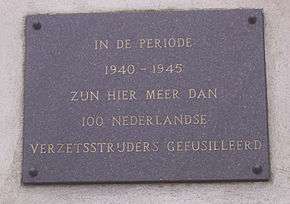

After the Soviets ceased to use Sachsenhausen as a concentration camp the site was used, for some years, by East Germany's "Kasernierte Volkspolizei", notionally a police division and in reality a precursor of the country's own army which was formally established in 1956. 1956 was also the year in which planning began to adapt the concentration camp site as a national memorial. This was inaugurated four years later on 23 April 1961. The first director of the renamed "Sachsenhausen National Memorial" ("Nationalen Mahn- u. Gedenkstätte Sachsenhausen") was Christian Mahler, at one time a senior police officer, who back in the Nazi period had been an inmate at Sachsenhausen between 1938 and 1943.[23] The plans involved the removal of most of the original buildings and the construction of an obelisk, statue and meeting area, reflecting the outlook of the East German government of that time.
The government of East Germany emphasised the suffering of political prisoners over that of the other groups detained at Sachsenhausen. The memorial obelisk contains eighteen red triangles, the symbol the Nazis gave to political prisoners, usually communists. There is a plaque in Sachsenhausen built in memory of the Death March. This plaque has a picture of malnourished male prisoners marching, all of whom are wearing the red triangle of a political prisoner.
As of 2015, the site of the Sachsenhausen camp, at Strasse der Nationen 22 in Oranienburg, is open to the public as a museum and a memorial. Several buildings and structures survive or have been reconstructed, including guard towers, the camp entrance, crematory ovens and the camp barracks.
After German reunification, the camp was entrusted to a foundation that opened a museum on the site. The museum features artwork created by inmates and a 30-centimetre (12 in) high pile of gold teeth (extracted by the Germans from the prisoners), scale models of the camp, pictures, documents and other artifacts illustrating life in the camp. The administrative buildings from which the entire German concentration camp network was run have been preserved and can also be seen.
Following the discovery in 1990 of mass graves from the Soviet period, a separate museum has been opened documenting the camp's Soviet-era history, in the former Sonderlager.
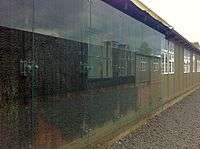
The compound has been vandalized by Neo-Nazis several times. In September 1992, barracks 38 and 39 of the Jewish Museum were severely damaged in an arson attack. The perpetrators were arrested, and the barracks were reconstructed by 1997.[24]
Sites within Sachsenhausen and Dachau which had been approved for inclusion in the augmented reality smartphone game Ingress were removed in July 2015; Gabriele Hammermann, director of the memorial site at Dachau, told the Deutsche Presse-Agentur that Google's actions were a humiliation for victims and relatives of the Nazi camps, and Niantic Labs' founder John Hanke stated that "we apologize that this has happened." [25]
Gallery

 Sachsenhausen gate Arbeit macht frei
Sachsenhausen gate Arbeit macht frei Sachsenhausen Memorial Detail
Sachsenhausen Memorial Detail Death March memorial plaque – Sept 2010
Death March memorial plaque – Sept 2010- Soviet Liberation Memorial – full size – Nov 2005
 There are eighteen red triangles on each side of the Memorial Obelisk – Sept 2010
There are eighteen red triangles on each side of the Memorial Obelisk – Sept 2010 The Memorial
The Memorial Memorial statue at the base of the Obelisk – Sept 2010
Memorial statue at the base of the Obelisk – Sept 2010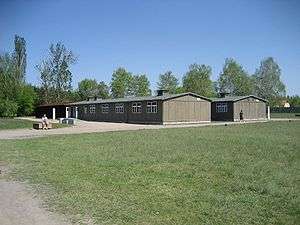 Jewish barracks and museum, 2006
Jewish barracks and museum, 2006 Sachsenhausen Crematorium, Oranienburg, Berlin, 2009
Sachsenhausen Crematorium, Oranienburg, Berlin, 2009 Sachsenhausen Crematorium Memorial, Oranienburg, Berlin, 2009
Sachsenhausen Crematorium Memorial, Oranienburg, Berlin, 2009 Commemorative postage stamp
Commemorative postage stamp- Main entrance, July 2006
 One of the perimeter watchtowers, May 2007
One of the perimeter watchtowers, May 2007 Prisoner's uniform. May 2007
Prisoner's uniform. May 2007 Pathology Block over Mortuary Cellar used for storing bodies prior to cremation
Pathology Block over Mortuary Cellar used for storing bodies prior to cremation Infirmary Barracks, later used for medical experiments and now housing an exhibition.
Infirmary Barracks, later used for medical experiments and now housing an exhibition. The green building beyond the entrance gate is the remnants of the SS troop barracks
The green building beyond the entrance gate is the remnants of the SS troop barracks Entrance viewed from the Roll Call Area
Entrance viewed from the Roll Call Area Wall around Roll Call Area indicating positions of barrack blocks
Wall around Roll Call Area indicating positions of barrack blocks Execution Trench
Execution Trench Execution trench
Execution trench Medical post mortem table
Medical post mortem table- Sachsenhausen Concentration Camp, Oranienburg, Berlin, 2007
 Toilet inside the barracks
Toilet inside the barracks Bunk beds inside the barracks
Bunk beds inside the barracks Prison cell
Prison cell Boot-testing track, used especially by pink triangle (homosexual) prisoners
Boot-testing track, used especially by pink triangle (homosexual) prisoners
See also
- List of subcamps of Sachsenhausen
- List of Nazi concentration camps
- International concentration camp committees
Footnotes
- ↑ Niven, Bill (2002). Facing the Nazi Past (1st ed.). Routledge. p. 11.
- ↑ "Sachsenhausen - Oranienburg (Germany)". Retrieved 2012-08-21.
- ↑ "History of Sachsenhausen". Jewish Virtual Library.
- ↑ Lebor, Adam; Boyes, Roger (2000). Surviving Hitler (1st ed.). Simon & Schuster. p. 230.
- ↑ "Use of Prisoners in the aircraft industry (translated)". Nazi Conspiracy and Aggression Volume IV. The Avalon Project at Yale Law School. 1996–2007. Retrieved 2008-02-25.
- ↑ Ernst Klee: the person lexicon to the Third Reich. Who was what before and after 1945 S. Fischer Verlag, Frankfurt am Main 2003, p. 681.
- ↑ Florian Schmalz: Weapon research in Nazi Germany. The cooperation of the Kaiser Wilhelm companies, military and industry. Göttingen 2005, ISBN 3-89244-880-9. Available online: Weapon research
- ↑ http://www.theguardian.com/world/2002/nov/19/research.germany
- ↑ D-IX
- ↑ "Title unknown". Archived from the original on 2015-01-22.
- ↑ Evans, Richard J (2006). The Third Reich in Power. London: Penguin Books. pp. 255–256. ISBN 0-14-100976-4.
- ↑ Sachsenhausen concentration camp
- ↑ US Holocaust Memorial Museum. "Blacks During the Holocaust". Holocaust Encyclopedia. Retrieved 26 September 2012.
- ↑ Ottosen, Kristian, ed. (2004). Nordmenn i fangenskap 1940–1945 (in Norwegian) (2nd ed.). Oslo: Universitetsforlaget. p. 420. ISBN 82-15-00288-9.
- ↑ September 17, 1939 The New York Times
- ↑ He Died For a Principle, Watch Tower Society
- ↑ A Teacher's Guide to the Holocaust, Florida Center for Instructional Technology
- ↑ Schönhaus, Cioma (2004). The Forger. Grant Books.
- 1 2 "The Soviet special camp No.7 / No. 1 1945 - 1950". Retrieved 2012-08-24.
- ↑ Butler, Desmond (17 December 2001). "Ex-Death Camp Tells Story of Nazi and Soviet Horrors". The New York Times. Retrieved 2012-08-24.
- ↑ Utley, Freda (1949). "6 The Nuremberg Judgments". The High Cost of Vengeance. Henry Regnery Company. Retrieved 2012-08-24.
- ↑ Kinzer, Stephen (24 September 1992). "Germans Find Mass Graves at an Ex-Soviet Camp". The New York Times. Retrieved 2012-08-24.
- ↑ Bernd-Rainer Barth. "Mahler, Christian * 12.11.1905, † 30.5.1966 Direktor der Nationalen Mahn- u. Gedenkstätte Sachsenhausen". Bundesstiftung zur Aufarbeitung der SED-Diktatur: Biographische Datenbanken. Retrieved 22 December 2014.
- ↑ Mangasarian, Leon (29 August 1993). "Swastikas desecrate Sachsenhausen concentration camp memorial". United Press International. Retrieved 2012-08-24.
- ↑ http://www.nbcnews.com/news/world/googles-niantic-labs-sorry-over-death-camps-smartphone-game-n385741
References
- Pingel, Falk, ed. (1990). Encyclopaedia of the Holocaust. 4. New York: Macmillan. pp. 1321–1322. Photo
- "General information on the Sachsenhausen concentration camp". web site of the "Brandenburg Memorial Foundation: Memorial and Museum Sachsenhausen". Archived from the original on March 9, 2005.
- Foot, Michael Richard Daniel; Langley, J M (1979). MI9 – Escape and Evasion 1939–1945. Book Club Associates. ISBN 0-316-28840-3.
Further reading
- Finn, Gerhard (1988). Sachsenhausen 1936–1950 : Geschichte eines Lagers. Bad Münstereifel: Westkreuz-Verlag. ISBN 3-922131-60-3.
- Andrea Riedle: Die Angehörigen des Kommandanturstabs im KZ Sachsenhausen. Sozialstruktur, Dienstwege und biografische Studien, Metropol Verlag, Berlin 2011, ISBN 978-3-86331-007-3.
-
 Oranienburg travel guide from Wikivoyage
Oranienburg travel guide from Wikivoyage
External links
| Wikimedia Commons has media related to Sachsenhausen concentration camp. |
- History of the Sachsenhausen-Oranienburg camp on the Jewish Virtual Library part of the American-Israeli Cooperative Enterprise
- Sachsenhausen among the Nazi camps (Germany), with list of its subcamps on a site is hosted by JewishGen, Inc
- Gedenkstätte und Museum Sachsenhausen
- Guide to the Concentration Camps Collection at the Leo Baeck Institute, New York, NY. Contains lists of prisoners and correspondence from Sachsenhausen.
Coordinates: 52°45′57″N 13°15′51″E / 52.76583°N 13.26417°E